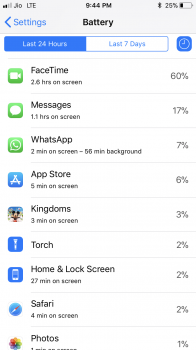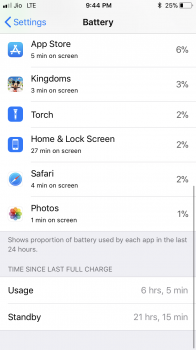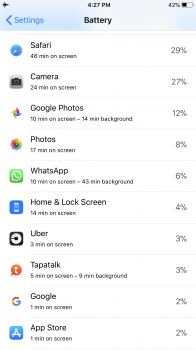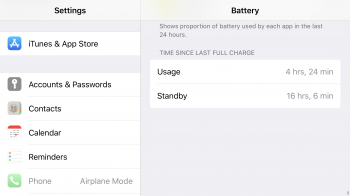Same here, I don't understand what the heck you guys are doing to your cables. I still have all of my original cables...never an issue.A lot of users do go through lightning cables like dental floss but I am curious how you guys treat them. I still have my first lightning cable from the first lightning cable iPhone. Some MFI cables are durable and thicker feel as if its higher quality but Apple lightning is as same in comparison. I also notice MFI cables at the USB end tends to heat up compared to Apple USB end which I stick to Apple cable. I stick to the normal 5W adapter since iPad charger creates too much heat and degrades battery life over time.
Got a tip for us?
Let us know
Become a MacRumors Supporter for $50/year with no ads, ability to filter front page stories, and private forums.
iOS 11.2 Beta 5 Bug Fixes, Changes, and Improvements
- Thread starter Banglazed
- WikiPost WikiPost
- Start date
- Sort by reaction score
You are using an out of date browser. It may not display this or other websites correctly.
You should upgrade or use an alternative browser.
You should upgrade or use an alternative browser.
- Status
- The first post of this thread is a WikiPost and can be edited by anyone with the appropiate permissions. Your edits will be public.
I would agree about using quality cable, although I don't work in electronics, I dealt with this on an almost daily basis in the school picture business as, the equipment manager for 26 years. I have some education in electronics and more importantly, years of experience. I am certainly not an expert by any means.
However, a longer cable will almost certainly have a higher internal resistance therefore output voltages and wattage can potentially be lower going into the phone.
That said, I have used a 6 foot Onn lightening cable purchased at Walmart with no apparent issues in a year.
I previously had an Apple cable, given to me when my sister gave me my first Iphone, her old 5c.
She, like many others doesn't know how to properly take care of cables.
I see many people pull on their cords instead of grasping the connector to remove them. They eventually come apart where the cord enters the connector and eventually wires break or have an unreliable, lower resistance connection.
Furthermore people are often rolling up their cord in improper ways, even folding them. eventually they will become unreliable and inevitably,totally fail.
One of the other major variables here is the quality of the connector contact and the quality of the solder joints.
The older, lead solder was much more reliable, if done properly than the newer, environmental friendly ones.
Feel free to correct me on any of this, as I am certainly not an engineer.
Maybe this is getting off topic now, but does anybody care to share links to cable tests, or redirect me to a better place to post this on macrumors forums?
Thanks
I had posted a few back linking to Mobile Reviews, Eh:
https://www.mobilereviews-eh.ca/not-all-apple-lightning-cables-are-created-equal/
Nothing about an iPad charger is ultra fast or anything like that. So far based on experiences of many it doesn't appear to be tied to noticeable meaningful battery degradation.Something is messed up regarding the times. When I went to sleep at 12am the battery was fully charged to 100% and I had closed all apps in the background and turned on low power mode. When I woke up at 7:30AM usage time was 3 mins and standby time was just 1hour 12 mins. Now the battery is currently draining super fast. At 10AM it's already at 80%with 45 mins of use. Subpar to be honest.
[doublepost=1512123028][/doublepost]'
That guy's experience on Windows can also be justified as a sample size of 1. In my case, it's the absolute same with iOS. Only the most reported feedback is heard. The rest is thrown in the trash or left to wither away.
[doublepost=1512123726][/doublepost]
After my iPhone 6 battery got wrecked I have done a lot of reading on this and high charges can and do reduce battery life span and it's been proven by Battery university
http://batteryuniversity.com/learn/article/how_to_prolong_lithium_based_batteries
"Environmental conditions, not cycling alone, govern the longevity of lithium-ion batteries. The worst situation is keeping a fully charged battery at elevated temperatures. Battery packs do not die suddenly, but the runtime gradually shortens as the capacity fades.
Lower charge voltages prolong battery life and electric vehicles and satellites take advantage of this. Similar provisions could also be made for consumer devices, but these are seldom offered;
A laptop battery could be prolonged by lowering the charge voltage when connected to the AC grid. To make this feature user-friendly, a device should feature a “Long Life” mode that keeps the battery at 4.05V/cell and offers a SoC of about 80 percent. One hour before traveling, the user requests the “Full Capacity” mode to bring the charge to 4.20V/cell.
The question is asked, “Should I disconnect my laptop from the power grid when not in use?” Under normal circumstances this should not be necessary because charging stops when the Li-ion battery is full. A topping charge is only applied when the battery voltage drops to a certain level. Most users do not remove the AC power, and this practice is safe.
Modern laptops run cooler than older models and reported fires are fewer. Always keep the airflow unobstructed when running electric devices with air-cooling on a bed or pillow. A cool laptop extends battery life and safeguards the internal components. Energy Cells, which most consumer products have, should be charged at 1C or less. Avoid so-called ultra-fast chargers that claim to fully charge Li-ion in less than one hour.
Last updated 2017-11-17
That said, this really isn't the thread for this, and there are existing dedicated threads to that kind of topic that cover it fairly well.
I have two screenshot related bugs:
1. Edits made via the initial screenshot editor (cropping, specifically) don't save.
2. I just ran into an issue where I couldn't take another screen shot within 5 minutes of one. I had to reboot.
1. Edits made via the initial screenshot editor (cropping, specifically) don't save.
2. I just ran into an issue where I couldn't take another screen shot within 5 minutes of one. I had to reboot.
Just noticed this morning that my usage and standby times are matching up. Never had this issue prior to beta 5. I just rebooted and am now charging back up to 100% since I now have the two dashes instead of usage times.
The piece you are missing is this is talking Voltage not current. Both iPhone and iPad chargers are 5V. The difference between them is how much current they can supply. The device regulates how much current it wants/needs. Connect a car battery charger to a car battery and watch the meter. It will start out at a higher amperage (current) and slowly drop as the battery charges. The level is dependent on what the battery is requesting. A low charged battery will request more current initially and a battery with a more full charge will not and will start out at a lower current. Both will slowly drop towards zero as the battery charges until it is fully charged. Reason I mention this is you can actually see it happening with car battery chargers that have the amp meter. A bit harder to 'see' on iPhone.After my iPhone 6 battery got wrecked I have done a lot of reading on this and high charges can and do reduce battery life span and it's been proven by Battery university
http://batteryuniversity.com/learn/article/how_to_prolong_lithium_based_batteries
"Environmental conditions, not cycling alone, govern the longevity of lithium-ion batteries. The worst situation is keeping a fully charged battery at elevated temperatures. Battery packs do not die suddenly, but the runtime gradually shortens as the capacity fades.
Lower charge voltages prolong battery life and electric vehicles and satellites take advantage of this. Similar provisions could also be made for consumer devices, but these are seldom offered;
A laptop battery could be prolonged by lowering the charge voltage when connected to the AC grid. To make this feature user-friendly, a device should feature a “Long Life” mode that keeps the battery at 4.05V/cell and offers a SoC of about 80 percent. One hour before traveling, the user requests the “Full Capacity” mode to bring the charge to 4.20V/cell.
The question is asked, “Should I disconnect my laptop from the power grid when not in use?” Under normal circumstances this should not be necessary because charging stops when the Li-ion battery is full. A topping charge is only applied when the battery voltage drops to a certain level. Most users do not remove the AC power, and this practice is safe.
Modern laptops run cooler than older models and reported fires are fewer. Always keep the airflow unobstructed when running electric devices with air-cooling on a bed or pillow. A cool laptop extends battery life and safeguards the internal components. Energy Cells, which most consumer products have, should be charged at 1C or less. Avoid so-called ultra-fast chargers that claim to fully charge Li-ion in less than one hour.
Last updated 2017-11-17
That being said, your iPhone still draws power faster through the 10W iPad charger than it does with the 5W iPhone charger. The fact that it charges faster (still within safe limits) means it CAN degrade the battery faster as slower charging is always better for batteries. Whether or not this difference is noticeable in an iPhone battery is something I have not tested.The piece you are missing is this is talking Voltage not current. Both iPhone and iPad chargers are 5V. The difference between them is how much current they can supply. The device regulates how much current it wants/needs. Connect a car battery charger to a car battery and watch the meter. It will start out at a higher amperage (current) and slowly drop as the battery charges. The level is dependent on what the battery is requesting. A low charged battery will request more current initially and a battery with a more full charge will not and will start out at a lower current. Both will slowly drop towards zero as the battery charges until it is fully charged. Reason I mention this is you can actually see it happening with car battery chargers that have the amp meter. A bit harder to 'see' on iPhone.
Edit: We have derailed this thread, and I apologize for contributing to that. Back on topic. This beta is better than all previous iOS 11 iterations I have experienced. Haven’t had the unresponsive home button yet on my 7, and I encountered that almost daily since iOS 10.0
Last edited:
I kept an Apple cable in my travel bag, which involved having to roll it up so it didn't make a mess. Typically the cheap rubberized plastic sheath would break within 12-18 months.Same here, I don't understand what the heck you guys are doing to your cables. I still have all of my original cables...never an issue.
[doublepost=1512145179][/doublepost]
That's not bad considering the usage profile. Were those FaceTime video or audio calls? Speakerphone or Bluetooth headset?Battery life today, now need to put to charge..
Again, iPhone 7, 11.2 beta 5.
Did you see any improvement over beta 4Battery life today, now need to put to charge..
Again, iPhone 7, 11.2 beta 5.
Still getting bad battery life on 7 Plus
Attachments
Last edited:
I kept an Apple cable in my travel bag, which involved having to roll it up so it didn't make a mess. Typically the cheap rubberized plastic sheath would break within 12-18 months.
My previous Apple cables had that issue, especially that revised slim Dock Connector one. Ugh, you'd look at that one wrong and it's sheath would separate.
My recent 6' cables though, USB-A to Lightning and USB-C to Lightning, are fairing very well.
So I experienced another home WiFi connection drop on my 6s. It’s hard for me to not blame the beta because the wife’s 6s is on 11.1.2 and hasn’t seen any WiFi issues, nor did I have any problems (that I noticed) on betas 1-4.
I’ve reset every setting related to wifi, both on the phone and my AirPort Extreme, with no luck. Such is life in the beta world.
I’ve reset every setting related to wifi, both on the phone and my AirPort Extreme, with no luck. Such is life in the beta world.
I kept an Apple cable in my travel bag, which involved having to roll it up so it didn't make a mess. Typically the cheap rubberized plastic sheath would break within 12-18 months.
[doublepost=1512145179][/doublepost]
That's not bad considering the usage profile. Were those FaceTime video or audio calls? Speakerphone or Bluetooth headset?
Yep, I'm happy with this battery life, considering 25 percent remaining still. Also, I should say that initial betas seemed to perform better than last two.
These calls were FaceTime audio using the phone itself.
[doublepost=1512148774][/doublepost]
Did you see any improvement over beta 4
No. 11.2 beta 1 and probably 2 were very good, last two I have definitely noticed slight worsening. It's expected though. We are some betas away from final.
is this an instagram or iOS 11 bug :
Clicking on a second instagram notification from the lockscreen opens instagram with a blank white screen, image doesnt load.
A workaround is the swipe close the instagram app before opening each individual instagram notification.
All other apps notifications work, its only instagram.
Anybody else experience this?
Clicking on a second instagram notification from the lockscreen opens instagram with a blank white screen, image doesnt load.
A workaround is the swipe close the instagram app before opening each individual instagram notification.
All other apps notifications work, its only instagram.
Anybody else experience this?
gm beta 6 out
Beat me to it.
Time to go discuss Lightning cables and the broken weather widget there. Via con dios!
Yes correct, it can because the 10W is able to supply its request. And sure slower is typically better for any battery. But I mean hooking up to a 40W charger still doesn't mean its shooting power to the device just because the charger has that capability. The device is requesting an amt and it isn't going to request more that its supposed to have due to its internal circuitry and software. That was the point I was attempting to make. So basically the 10W charger will get it to its 80% faster (while monitoring temps) but then it doesn't really matter which charger. Apple itself states its ok: https://support.apple.com/en-us/HT202105That being said, your iPhone still draws power faster through the 10W iPad charger than it does with the 5W iPhone charger. The fact that it charges faster (still within safe limits) means it CAN degrade the battery faster as slower charging is always better for batteries. Whether or not this difference is noticeable in an iPhone battery is something I have not tested.
Edit: We have derailed this thread, and I apologize for contributing to that. Back on topic. This beta is better than all previous iOS 11 iterations I have experienced. Haven’t had the unresponsive home button yet on my 7, and I encountered that almost daily since iOS 10.0
https://www.apple.com/batteries/why-lithium-ion/
https://www.apple.com/batteries/why-lithium-ion/
It charges fast for convenience and slow for longevity.
Your Apple lithium-ion battery uses fast charging to quickly reach 80% of its capacity, then switches to slower trickle charging. The amount of time it takes to reach that first 80% will vary depending on your settings and which device you’re charging. Software may limit charging above 80% when the recommended battery temperatures are exceeded. This combined process not only lets you get out and about sooner, it also extends the lifespan of your battery.
Stage 1: Fast Charge
Gives you more power more quickly.
0%-80%
Stage 2: Trickle Charge
Eases the electrical current to extend battery lifespan.
Last edited:
Register on MacRumors! This sidebar will go away, and you'll see fewer ads.





